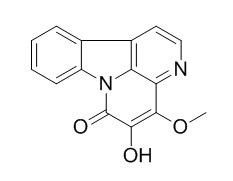5-Hydroxy-4-methoxycanthin-6-one
4-Methoxy-5- hydroxycanthin-6-one has anti-inflammatory effect, it can significantly inhibit the production of NO and the release of TNF-α induced by LPS in macrophage RAW 264.7, it has protective effect on dextran sulfate sodium -induced rat colitis. After oral administration, 4-methoxy-5- hydroxycanthin-6-one (3, 9, and 27 mg/kg) can reduce the development of carrageenan-induced paw edema and complete Freund's adjuvant (CFA)-induced chronic arthritis in rats. 5-Hydroxy-4-methoxycanthin-6-one exhibits significant cytotoxic activity against CNE2 cell line.
Inquire / Order:
manager@chemfaces.com
Technical Inquiries:
service@chemfaces.com
Tel:
+86-27-84237783
Fax:
+86-27-84254680
Address:
1 Building, No. 83, CheCheng Rd., Wuhan Economic and Technological Development Zone, Wuhan, Hubei 430056, PRC
Providing storage is as stated on the product vial and the vial is kept tightly sealed, the product can be stored for up to
24 months(2-8C).
Wherever possible, you should prepare and use solutions on the same day. However, if you need to make up stock solutions in advance, we recommend that you store the solution as aliquots in tightly sealed vials at -20C. Generally, these will be useable for up to two weeks. Before use, and prior to opening the vial we recommend that you allow your product to equilibrate to room temperature for at least 1 hour.
Need more advice on solubility, usage and handling? Please email to: service@chemfaces.com
The packaging of the product may have turned upside down during transportation, resulting in the natural compounds adhering to the neck or cap of the vial. take the vial out of its packaging and gently shake to let the compounds fall to the bottom of the vial. for liquid products, centrifuge at 200-500 RPM to gather the liquid at the bottom of the vial. try to avoid loss or contamination during handling.
AMB Express2020. 10(1):126.
ARPN Journal of Eng.& Applied Sci.2016, 2199-2204
Evid Based Complement Alternat Med.2021, 2021:8850744.
Molecules.2024, 29(21):5161.
HIV Med.2021, 22(8):690-704.
Food Chem.2019, 275:746-753
Applied Biological Chemistry2022, 71:s13765-022-00743-5.
Semyung University2017, 149407
Molecules.2021, 26(4):816.
Chinese Medicine2019, 14(1)
Related and Featured Products
J Asian Nat Prod Res. 2008 Nov-Dec;10(11-12):1009-12.
Canthin-6-one alkaloids from Picrasma quassioides and their cytotoxic activity.[Pubmed:
19031238]
METHODS AND RESULTS:
A new alkaloid, 4,5-dimethoxy-10-hydroxycanthin-6-one (1), was isolated from the stem of Picrasma quassioides Bennet (Simaroubaceae) together with four known canthin-6-one alkaloids, 8-hydroxycanthin-6-one (2), 4,5-dimethoxycanthin-6-one (3), 5-Hydroxy-4-methoxycanthin-6-one (4), and 3-methylcanthin-5,6-dione (5). Their structures were elucidated on the basis of spectroscopic data. The cytotoxic activity of the canthin-6-one alkaloids was evaluated using human nasopharyngeal carcinoma (CNE2) and human liver cancer (Bel-7402) cell lines.
CONCLUSIONS:
Among these isolates, compounds 1-4 exhibited significant cytotoxic activity against CNE2 cell line.
Phytomedicine. 2013 Feb 15;20(3-4):319-23.
In vitro and in vivo anti-inflammatory effects of 4-methoxy-5- hydroxycanthin-6-one, a natural alkaloid from Picrasma quassioides.[Pubmed:
23271002 ]
In the present study, we evaluated the anti-inflammatory effect of 4-methoxy-5- hydroxycanthin-6-one (5-Hydroxy-4-methoxycanthin-6-one,CAN), a natural alkaloid isolated from Picrasma quassioides.
METHODS AND RESULTS:
CAN significantly inhibited the production of NO and the release of TNF-α induced by LPS in macrophage RAW 264.7. Western blot showed that CAN can downregulate the expression of iNOS protein. After oral administration, CAN (3, 9, and 27 mg/kg) reduced the development of carrageenan-induced paw edema and complete Freund's adjuvant (CFA)-induced chronic arthritis in rats.
CONCLUSIONS:
The observed results indicated that pre-treatment with CAN might be an effective therapeutic intervention against inflammatory diseases including chronic arthritis.
Planta Med. 2009 Feb;75(2):142-5.
Protective effect of 4-methoxy-5-hydroxycanthin-6-one, a natural alkaloid, on dextran sulfate sodium-induced rat colitis.[Pubmed:
19085815]
METHODS AND RESULTS:
In the present study, we evaluated the effect of 4-methoxy-5-hydroxycanthin-6-one (5-Hydroxy-4-methoxycanthin-6-one, CAN), a natural alkaloid isolated from Picrasma quassioides (D.Don) Benn., on ulcerative colitis induced by dextran sulfate sodium (DSS) in rats in comparison with the positive control drug, sulfasalazine (SASP). Given orally for several days, CAN significantly reduced the severity of colitis and mitigated changes in colon length, colon mucosa myeloperoxidase (MPO) activity, and the level of tumor necrosis factor-alpha (TNF-alpha) in serum. The effect of CAN was similar to that of SASP.
CONCLUSIONS:
These results suggest that CAN treatment might be an effective therapeutic intervention against ulcerative colitis induced by DSS.
Chemistry of Natural Compounds,2014,50(5):884-888.
Seven Alkaloids from Picrasma quassioides and Their Cytotoxic Activities[Reference:
WebLink]
METHODS AND RESULTS:
A new alkaloid, 6-hydroxy-β-carboline-1-carboxylic acid (1), together with six known alkaloids, including β-carboline-1-carboxylic acid (2), β-carboline-1-propanoic acid (3), 1-methoxycarbonyl-β-carboline (4), 3-methylcanthin-5,6-dione (5), 5-Hydroxy-4-methoxycanthin-6-one (6), and 4,5-dimethoxycanthin-6-one (7), were isolated from the stem of Picrasma quassioides. Their structures were elucidated on the basis of spectroscopic data. Compounds 1–7 were screened for their cytotoxic activities against five cancer cell lines such as CT26.WT, K-562, SGC-7901, Hep G2, and A-549.
CONCLUSIONS:
Among the seven alkaloids tested, only compound 2 exhibited moderate inhibitory activities against K-562 and SGC-7901 cell lines.



